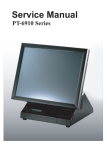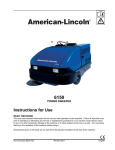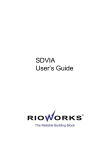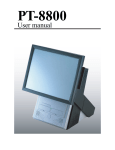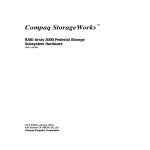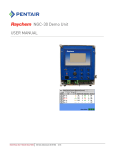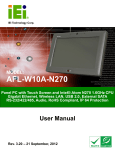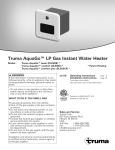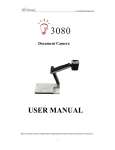Download User Manual
Transcript
User Manual PT-6910 Series Copyright This publication, including all photographs, illustrations and software, is protected under international copyright laws, with all rights reserved. Neither this manual, nor any of the material contained herein, may be reproduced without written consent of the author. Disclaimer The information in this document is subject to change without notice. The manufacturer makes no representations or warranties with respect to the contents hereof and specifically disclaims any implied warranties of merchantability or fitness for any particular purpose. The manufacturer reserves the right to revise this publication and to make changes from time to time in the content hereof without obligation of the manufacturer to notify any person of such revision or changes. Trademark Recognition All product names used in this manual are the properties of their respective owners and are acknowledged. Federal Communications Commission (FCC) This equipment has been tested and found to comply with the limits for a Class A digital device, pursuant to Part 15 of the FCC Rules. These limits are designed to provide reasonable protection against harmful interference in a residential installation. This equipment generates, uses, and can radiate radio frequency energy and, if not installed and used in accordance with the instructions, may cause harmful interference to radio communications. However, there is no guarantee that interference will not occur in a particular installation. If this equipment does cause harmful interference to radio or television reception, which can be determined by turning the equipment off and on, the user is encouraged to try to correct the interference by one or more of the following measures: • Reorient or relocate the receiving antenna. • Increase the separation between the equipment and the receiver. • Connect the equipment onto an outlet on a circuit different from that to which the receiver is connected. • Consult the dealer or an experienced radio/TV technician for help. Shielded interconnect cables and a shielded AC power cable must be employed with this equipment to ensure compliance with the pertinent RF emission limits governing this device. Changes or modifications not expressly approved by the system’s manufacturer could void the user’s authority to operate the equipment. Declaration of Conformity • This device complies with part 15 of the FCC rules. Operation is subject to the following conditions: • This device may not cause harmful interference, and • This device must accept any interference received, including interference that may cause undesired operation. i About this Manual PT-6910 Series POS Terminal Models This manual is for users of the PT-6910 Series. In the text we refer to any of these models as the PT-6910 Series, or to the specific model if there is a difference. The manual consists of the following sections: Chapter 1 Getting Started: This section covers unpacking and checking the package contents, and identifying components. Information on connecting peripheral devices, and powering on is also provided. Chapter 2 BIOS Setup Utility: The BIOS chapter provides information on navigating and changing settings in the BIOS Setup Utility. Chapter 3 Upgrading Components:This section provides information on upgrading components. Appendix: The appendix covers troubleshooting, information on having the PT-6910 Series serviced, and technical specifications. Safety information Before installing and using the PT-6910 Series POS, take note of the following precautions: • Read all instructions carefully. • Do not place the unit on an unstable surface, cart, or stand. • Do not block the slots and opening on the unit, which are provided for ventilation. • Do not push objects in the ventilation slots as they may touch high voltage components and result in shock and damage to the components. • The unit uses a three-wire ground cable, which is equipped with a third pin to ground the unit and prevent electric shock. Do not defeat the purpose of this pin. If your outlet does not support this kind of plug, contact your electrician to replace your obsolete outlet. • Do not place anything on the power cord. Place the power cord where it will not be in the way of foot traffic. • Follow all warnings and cautions in this manual and on the unit case. • When replacing parts, ensure that your service technician uses parts specified by the manufacturer. • Avoid using the system near water, in direct sunlight, or near a heating device. The system uses a 3V CR2032 battery mounted on the mainboard to keep time. There is a risk of explosion if the wrong battery type is used when replacing. Dispose of used batteries according to local ordinance WARNING regulations. The USB ports can be damaged if care is not taken when connecting devices. Ensure USB devices are correctly inserted. Plugging a phone line into the LAN port (RJ-45 connector) can damage CAUTION the connector. Take care only plug an RJ-45 connector into the LAN port. Revision history Version 1.0, November 2008 ii TABLE OF CONTENTS PT-6910 Series POS Terminal Models ��������������������������������������������������������� ii CHAPTER 1 GETTING STARTED������������������������������������������������ 1 PT-6910 Series POS Terminal Models ���������������������������������������������������������1 Unpacking������������������������������������������������������������������������������������������������������1 Unpacking the Machine ��������������������������������������������������������������������������������1 Checking the package contents ��������������������������������������������������������������������2 Identifying components ���������������������������������������������������������������������������������3 Removing the rear cover��������������������������������������������������������������������������������7 Attaching the Customer Display (PT-6910 / PT-6915F)���������������������������������8 Attaching the Customer Display (PT-6915)����������������������������������������������������9 Adjusting the Customer Display Angle (PT-6910 / PT-6915F)���������������������10 Setup Considerations�����������������������������������������������������������������������������������10 Connecting Peripheral Devices��������������������������������������������������������������������11 Connecting a Cash Drawer��������������������������������������������������������������������������12 Powering the PT-6910 Series On and Off����������������������������������������������������13 CHAPTER 2 BIOS SETUP���������������������������������������������������������� 15 About the Setup Utility ��������������������������������������������������������������������������������15 Entering the Setup Utility ������������������������������������������������������������������������16 BIOS Navigation Keys�����������������������������������������������������������������������������16 Using BIOS ���������������������������������������������������������������������������������������������17 Standard CMOS Features���������������������������������������������������������������������������18 Advanced BIOS Features����������������������������������������������������������������������������20 CPU Feature������������������������������������������������������������������������������������������������21 Hard Disk Boot Priority���������������������������������������������������������������������������������22 Advanced Chipset Features�������������������������������������������������������������������������23 Integrated Peripherals����������������������������������������������������������������������������������25 ► OnChip IDE Device�����������������������������������������������������������������������������26 ► Onboard Device����������������������������������������������������������������������������������28 ► SuperIO Device�����������������������������������������������������������������������������������29 Power Management Setup��������������������������������������������������������������������������30 PnP/PCI Configurations�������������������������������������������������������������������������������32 ► IRQ Resources������������������������������������������������������������������������������������33 PC Health Status�����������������������������������������������������������������������������������������34 Frequency/Voltage Control��������������������������������������������������������������������������35 Other BIOS Options�������������������������������������������������������������������������������������36 iii CHAPTER 3 UPGRADING COMPONENTS������������������������������� 39 Safety and Precautions �������������������������������������������������������������������������������39 Before You Begin ����������������������������������������������������������������������������������������40 Installing a hard disk drive ��������������������������������������������������������������������������40 Installing a CompactFlash card (PT-6910 / PT-6915F)��������������������������������42 APPENDIX���������������������������������������������������������������������������������� 44 Troubleshooting�������������������������������������������������������������������������������������������44 Tips for Troubleshooting�������������������������������������������������������������������������������44 The Power-On Self Test�������������������������������������������������������������������������������44 Beep Errors at POST�����������������������������������������������������������������������������������44 Beep Message Errors at POST �������������������������������������������������������������������45 General Problems ���������������������������������������������������������������������������������������46 Having the PT-6910 Series Serviced ����������������������������������������������������������47 Specifications�����������������������������������������������������������������������������������������������48 iv CHAPTER 1 GETTING STARTED PT-6910 Series POS Terminal Models This manual is for users of the PT-6910 Series. In the text we refer to any of these models as the PT-6910 Series, or to the specific model if there is a difference. Unpacking This chapter describes the procedures from unpacking the PT-6910 Series POS, to powering it on. The following topics are described. • • • • • • • • • Unpacking the machine on page 1 Checking the package contents on page 2 Identifying components on page 3 Removing the rear cover on page 7 Attaching the customer display on page 8 Adjusting display angles on page 8 Connecting peripheral devices on page 10 Connecting a cash drawer on page 11 Powering the PT-6910 Series on and off on page 12 Unpacking the Machine The machine and cable accessories are packed in a cardboard carton with foam padding for protection during shipping. Figure 1.1 Unpacking the machine Carefully unpack the machine and keep the packing materials. If you need to ship it in the future, repack it as shown in Figure 1.1. 1 Checking the package contents After you unpack the device check that the following items are included. Power Cable PT-6910 Series (Some units ship with customer display and MSR installed. System QIG Power Adapter System QIG 1. User Manual and Driver CD 2. WEPOS Recovery DVD (optional) CF Card Reader (optional) Customer Display (optional) MSR (optional) If any item is missing or appears damaged, contact your dealer immediately. 2 C H A P T E R 1 G E T T I N G S TA R T E D Identifying components This section describes the parts and connectors on the machine. Front-right view 1 2 3 4 5 USB Cover Figure 1.2 Front-right view Component Description 1 15-inch TFT LCD touch screen 2 Power Button 3 USB Cover 4 Green Power indicator LED 5 Amber Hard drive activity LED 3 Rear view PT-6915 PT-6910 / PT-6915F 1 2 3 4 Figure 1.3 Rear view Component 4 Description 1 Heat sink rear cover (PT-6915) 2 CompactFlash card cover 3 Rear cover 4 Rear cover latches C H A P T E R 1 G E T T I N G S TA R T E D I/O connectors 1 2 34 16 15 5 6 14 13 7 12 8 11 10 9 Figure 1.4 PT-6910 Series I/O connectors Connector Description 1 Audio Line out 2 Act LED (green) lights when network activity is detected 3 RJ-45 (LAN) connector 4 Link LED (orange) lights when the network is found 5 PS/2 mouse connector 6 COM3 connector 7 Parallel connector 8 COM2 connector 9 Power connector 10 RJ-11 cash drawer connector 11 COM1 connector 12 VGA connector 13 COM4 14 PS/2 keyboard connector 15 USB connectors 16 Mic in 5 CAUTION Do not plug a phone line into the RJ-45 (ADSL or router) connector. Doing so can damage the connector. COM6 is reserved for the optional customer display. NOTE NOTE 6 C H A P T E R 1 G E T T I N G S TA R T E D Removing the rear cover Refer to the following to remove the rear cover. 1. Tilt the display to its full vertical orientation. 2. Release the rear cover latches. 3. Remove the rear cover. 7 Attaching the Customer Display (PT-6910 / PT-6915F) The PT-6910 and PT-6915F may ship with a customer display attached. If you ordered the display separately, refer to the following to attach it. 1. Remove the customer display cover by sliding it in the direction shown by the arrow. 2. Connect the customer display cable. 3. Align the groove on the customer display bracket and slide the customer display firmly into place. 4. Secure the display with the two supplied screws. To supply power to the customer display, the COM6 voltage is factory set to DC+12V. NOTE 8 C H A P T E R 1 G E T T I N G S TA R T E D Attaching the Customer Display (PT-6915) The PT-6915 may ship with a customer display attached. If you ordered the display separately, refer to the following to attach it. 1. Connect the customer display cable. 2. Line up the bracket with the holes in the rear of the housing and secure with two screws. To supply power to the customer display, the COM6 voltage is factory set to DC+12V. NOTE 9 Adjusting the Customer Display Angle (PT-6910 / PT-6915F) The main display can be tilted back from an upright position to about 45 degrees as shown in Figure 1.5. The customer display can be tilted as shown in Figure 1.6. Note: The customer display for the PT-6915 is fixed and cannot be adjusted. Figure 1.5 Adjusting the display Figure 1.6 Adjusting the customer display Setup Considerations When setting up the PT-6910 Series, consider the following: • Place the unit on a stable and even surface • Ensure there is enough room around the sides and rear of the PT-6910 Series for ventiliation • Ensure there is room to connect cables and that cables are long enough to reach peripheral devices or a power outlet 10 C H A P T E R 1 G E T T I N G S TA R T E D Connecting Peripheral Devices Peripheral devices such as a printer or scanner can be connected to the machine. Refer to the user manual of the device you are connecting for instructions on installing drivers where needed. 28800bps MR HS AA CD OH SD RD TR ADSL modem or router !MPLIFIEROR SPEAKERS Mouse Printer COM2 COM3 Headphones COM4 COM1 Power plug Microphone USB Compliant devices Keyboard Monitor Cashdrawer Figure 1.7 Connecting peripheral devices CAUTION Do not plug a phone line into the RJ-45 (ADSL or router) connector. Doing so can damage the connector. 11 Connecting a Cash Drawer Refer to the following to connect a cash drawer. IMPORTANT The cash drawer RJ-11 connector is DC+24V. Ensure the cash drawer to be connected matches this power specification. 1. Remove the rear cover (See “Removing the rear cover” on Page 7. 2. Connect the RJ-11 cable from the cash drawer to the RJ-11 connector on the PT-6910 Series as shown in Figure 1.8. Figure 1.8 Connecting a cash drawer Cashdrawer 3. Turn on the PT-6910 Series (See “Powering the PT-6910 Series on and off” below.) 12 C H A P T E R 1 G E T T I N G S TA R T E D Powering the PT-6910 Series On and Off Refer to the following to power on and off the machine. 1. Remove the rear cover . (See “Removing the rear cover” on page 7.) 2. Connect the power cable to the power connector on the PT-6910 Series rear panel and to the AC adapter. Adapter 3. Connect the AC adapter to an electrical outlet. 4. Press the power button on the underside of the display panel. The power LED turns on. 5. To turn off the PT-6910 Series, shut down the operating system. The main power turns off automatically. NOTE You may need to force power off the machine, for example if the operating system you are using does not support power down by the OS or if the system crashes or hangs. To force power off, press and keep the power button pressed for five seconds. 13 14 C H A P T E R 1 G E T T I N G S TA R T E D CHAPTER 2 BIOS SETUP The primary function of the BIOS (Basic Input and Output System) is to identify and initiate component hardware. The BIOS parameters are stored in non-volatile BIOS memory (CMOS). CMOS contents don’t get erased when the computer is turned off. The following topics are described in this chapter. • • • • • • • • • • • About the Setup Utility on page 14 Entering the Setup Utility on page 15 Standard BIOS Setup on page 17 Advanced BIOS Features on page 18 Advanced Chipset Features on page 20 Integrated Peripherals on page 22 Power Management Setup on page 26 PnP/PCI Configurations on page 28 PC Health Status on page 30 Frequency/Voltage Control on page 31 Other BIOS Options on page 32 About the Setup Utility The BIOS Setup Utility enables you to configure the following items: • Hard drives, diskette drives, and peripherals • Video display type and display options • Password protection from unauthorized use • Power management features This Setup Utility should be used for the following: • When changing the system configuration • When a configuration error is detected and you are prompted to make changes to the Setup Utility • When trying to resolve IRQ conflicts • When making changes to the Power Management configuration • When changing the User or Supervisor password 15 Entering the Setup Utility When you power on the system, BIOS enters the Power-On Self Test (POST) routines. POST is a series of built-in diagnostics performed by the BIOS. After the POST routines are completed, the following message appears: Press DEL to enter SETUP Press the delete key <Delete> to access the Award BIOS Setup Utility: Phoenix - AwardBIOS CMOS Setup Utility ►►Standard CMOS Feature ►►Frequency/Voltage Control ►►Advanced BIOS Features Load Fail-Safe Defaults ►►Advanced Chipset features Load Optimized Defaults ►►Integrated Peripherals Set Supervisor Password ►►Power Management Setup Set User Password ►►PnP/PCI Configurations Save & Exit Setup ►►PC Health Status Exit Without Saving Esc : Quit F10 : Save & Exit Setup ↑ ↓ → ← : Select Item Time, Date, Hard Disk Type... Figure 2.1 Main BIOS menu BIOS Navigation Keys The BIOS navigation keys are listed below. Key Function ←↑↓→ Scrolls through the items on a menu +/–/PU/PD Modifies the selected field’s values Esc Exits the current menu F1 Displays a screen that describes all key functions F5 Loads previously saved values to CMOS F6 Loads a minimum configuration for troubleshooting F7 Loads an optimum set of values for peak performance F10 Saves the current configuration and exits Setup 16 CHAPTER 2 BIOS SETUP Using BIOS When you start the Setup Utility, the main menu appears. The main menu of the Setup Utility displays a list of the options that are available. A highlight indicates which option is currently selected. Use the cursor arrow keys to move the highlight to other options. When an option is highlighted, execute the option by pressing <Enter>. Some options lead to pop-up dialog boxes that prompt you to verify that you wish to execute that option. Other options lead to dialog boxes that prompt you for information. Some options (marked with a triangle ►) lead to submenus that enable you to change the values for the option. Use the cursor arrow keys to scroll through the items in the submenu. 17 Standard CMOS Features Selecting Standard CMOS Features on the main menu displays the following menu: Phoenix - AwardBIOS CMOS Setup Utility Standard CMOS Features Date (mm:dd:yy) Time (hh:mm:ss) ►►IDE ►►IDE ►►IDE ►►IDE ►►IDE ►►IDE Channel Channel Channel Channel Channel Channel 0 0 2 2 3 3 Master Slave Master Slave Master Slave Video Halt On Base Memory Extended Memory Total Memory ↑↓→←:Move Enter:Select F5:Previous Values Thu, Oct 22 2008 8 : 33 : 14 Item Help [ None] [ None] [ST380815AS] [ None] [ None] [ None] [EGA/VGA] [All , But Keyboard] Figure 2.2 Standard CMOS Features menu 640K 514048K 515072K +/-/PU/PD:Value F10:Save ESC:Exit F1:General Help F6:Fail-Safe Defaults F7:Optimized Defaults Date and Time The Date and Time items show the current date and time held by the machine. If you are running a Windows OS, these items are automatically updated whenever you make changes to the Windows Date and Time Properties utility. Video These fields is used to select the default video device. The default setting is EGA/VGA. Halt On This item defines the operation of the system POST (Power On Self Test) routine. You can use this item to select which types of errors in the POST are sufficient to halt the system. Base Memory, Extended Memory, and Total Memory These items are automatically detected by the system at start up time. These are display-only fields. You cannot make changes to these fields. • Base Memory – This field displays the amount of conventional memory detected by the system during boot. • Extended Memory – This field displays the amount of extended memory detected by the system during boot. • Total Memory – This field displays the total amount of memory (Base and Extended) detected by the system during boot. 18 CHAPTER 2 BIOS SETUP IDE Channel 0/2/3 Master/Slave This field is used to configure the IDE hard drive installed in the system. Move the cursor to highlight the IDE Primary/Secondary Master/Slave fields and press <Enter>. The IDE Primary Master submenu opens: Phoenix - AwardBIOS CMOS Setup Utility IDE Channel 2 Master IDE HDD Auto-Detection [Press Enter] IDE Channel 0 Master Access Mode [Auto] [Auto] Capacity 80 MB Cylinder Head Precomp Landing Zone Sector 38309 16 0 39309 255 ↑↓→←:Move Enter:Select F5:Previous Values Item Help Figure 2.3 IDE Channel 2 Master menu +/-/PU/PD:Value F10:Save ESC:Exit F1:General Help F6:Fail-Safe Defaults F7:Optimized Defaults IDE HDD Auto-Detection Press Enter while this item is highlighted if you want the Setup Utility to automatically detect and configure a hard disk drive on the IDE channel. (Note: If you are setting up a new hard disk drive that supports LBA mode, moe than one line will appear in the parameter box. Choose the line that lists LBA for an LBA drive.) IDE Channel 0/2/3 Master/Slave If you leave this item at Auto, the system will automatically detect and configure any IDE devices it finds. If it fails to find a hard disk, change the value to Manual and then manually configure the drive by entering the characteristics of the drive in the fields described below: • Capacity – displays the capacity of the HDD in megabytes (MB). • Cylinder – indicates the number of cylinders that the HDD has. A cylinder is the sum total of all tracks that are in the same location on every disk surface. • Head – displays the number of heads in the HDD. A head is a device that reads and writes data on the hard disk. • Precomp – displays the track where precompensation is initiated. Precompensation is a feature whereby the HDD uses a stronger magnetic field to write data in sectors that are closer to the center of the disk. In CAV recording, in which the disk spins at a constant speed, the sectors closest to the spindle are packed tighter than the outer sectors. • Landing Zone – displays the location of the safe non-data area on a hard disk that is used for parking the read/write head. • Sector – displays the number of sectors available on the HDD. A sector is the smallest unit of storage space on a disk. Access Mode This item defines special ways that can be used to access IDE hard disks such as LBA (Large Block Addressing). Leave this value at Auto and the system will automatically decide the fastest way to access the hard disk drive. 19 Advanced BIOS Features Selecting Advanced BIOS Features on the main menu opens up this screen: Phoenix - AwardBIOS CMOS Setup Utility Advanced BIOS Features ►►CPU Feature [Press Enter] ►►Hard Disk Boot Priority [Press Enter] First Boot Device [USB-ZIP] Second Boot Device [USB-CDROM] Third Boot Device [Hard Disk] Boot Other Device [Enabled] Boot Up NumLock Status [On] Gate A20 Option [Fast] Typematic Rate Setting [Disabled] Security Option [Setup] xx Typematic Rate (Chars/Sec) 6 xx Typematic Delay (Msec) 250 APIC Mode [Enabled] MPS Version Control For OS[1.4] Full Screen LOGO Show [Disabled] Small Logo(EPA) Show [Enabled] ↑↓→←:Move Enter:Select F5:Previous Values Item Help Figure 2.4 Advanced BIOS Features menu +/-/PU/PD:Value F10:Save ESC:Exit F1:General Help F6:Fail-Safe Defaults F7:Optimized Defaults First/Second/Third Boot Device The BIOS loads the operating system from the disk drives in the sequence selected in these three fields. The default setting is USB-ZIP/USB-CDROM/Hard Disk. Boot Other Device When enabled, the system searches all other possible locations for an operating system if it fails to find one in the devices specified under the First, Second, and Third boot devices. The default setting is Enabled. Security Option Select whether the password is required every time the system boots or only when you enter setup. The default setting is Setup. Option Description System The system will not boot and access to Setup will be denied if the correct password is not entered at the prompt. Setup The system will boot, but access to Setup will be denied if the correct password is not entered at the prompt. APIC Mode This item is used to activate the ACPI (Advanced Configuration and Power Management Interface) Mode. The default setting is Enabled. ACPI is a power management specification that makes hardware status information available to the operating system. ACPI enables a PC to turn its peripherals on and off for improved power management. It also allows the PC to be turned on and off by external devices, so that IMPORTANT mouse or keyboard activity wakes up the machine. 20 CHAPTER 2 BIOS SETUP CPU Feature Selecting CPU Feature opens up this screen. Phoenix - AwardBIOS CMOS Setup Utility CPU Feature Delay Prior to Thermal Thermal Management Execute Disable Bit [16 Min] Thermal Monitor 1 [Enabled] Item Help Figure 2.5 CPU Feature submenu ↑↓→←:Move Enter:Select F5:Previous Values +/-/PU/PD:Value F10:Save ESC:Exit F1:General Help F6:Fail-Safe Defaults F7:Optimized Defaults Delay Prior to Thermal The Delay Prior To Thermal BIOS feature controls the activation of the Thermal Monitor’s automatic mode. It allows you to determine when the Pentium 4’s Thermal Monitor should abe activated in automatic mode after the system boots. For example, with the default value of 16 minutes after the system starts booting up. Execute Disable Bit When disabled, forces the XD feature flag to always return 0. 21 Hard Disk Boot Priority Selecting Hard Disk Boot Priority opens up this screen. Phoenix - AwardBIOS CMOS Setup Utility Hard Disk Boot Priority 1. Ch2 M. : ST380815AS 2. Bootable Add-in Cards Item Help Figure 2.6 Hard Disk Boot Priority menu ↑↓→←:Move Enter:Select F5:Previous Values +/-/PU/PD:Value F10:Save ESC:Exit F1:General Help F6:Fail-Safe Defaults F7:Optimized Defaults Hard Disk Boot Priority This screen allows setting the boot priority. Use the PageUp and PageDown to change the order. And then his Esc to set. 22 CHAPTER 2 BIOS SETUP Advanced Chipset Features This option displays critical timing parameters of the mainboard. Leave the items on this menu at their default settings unless you are very familiar with the technical specifications of the system hardware. If you change the values incorrectly, you may introduce fatal errors or recurring instability into the system. Phoenix - AwardBIOS CMOS Setup Utility Advanced Chipset Features DRAM Timing Selectable xx CAS Latency Time xx DRAM RAS# to CAS# Delay xx DRAM RAS# Precharge xx Precharge delay (tRAS) xx System Memory Frequency System BIOS Cacheable Video BIOS Cacheable [By SPD] 2 3 3 9 400MHz [Enabled] [Disabled] Item Help ** VGA Setting ** On-Chip Frame Buffer Size [8MB] ↑↓→←:Move Enter:Select F5:Previous Values Figure 2.7 Advanced Chipset Features menu +/-/PU/PD:Value F10:Save ESC:Exit F1:General Help F6:Fail-Safe Defaults F7:Optimized Defaults DRAM Timing Selectable Set this to the default value to enable the system to automatically set the SDRAM timing by SPD (Serial Presence Detect). SPD is an EEPROM chip on the DIMM module that stores information about the memory chips it contains, including size, speed, voltage, row and column addresses, and manufacturer. The default value is By SPD. CAS Latency Time When the DRAM Timing Selectable is set to [Manual], this field is adjustable. When synchronous DRAM is installed, the number of clock cycles of CAS latency depends on the DRAM timing. The default value is 2.5. DRAM RAS# to CAS# Delay When the DRAM Timing Selectable is set to [Manual], this field is adjustable. This field lets you insert a timing delay between the CAS and RAS strobe signals, used when DRAM is written to, read from, or refreshed. Fast gives faster performance; and Slow gives more stable performance. This field applies only when synchronous DRAM is installed in the system. The default value is 3. DRAM RAS# Precharge When the DRAM Timing Selectable is set to [Manual], this field is adjustable. This setting controls the number of cycles for Row Address Strobe (RAS) to be allowed to precharge. If insufficient time is allowed for the RAS to accumulate its charge before DRAM refresh, refresh may be incomplete and DRAM may fail to retain data. This item applies only when synchronous DRAM is installed in the system. The default value is 3. Precharge delay This feature allows user to set Active to Precharge Delay, if any SDRAM installed. The options are: Auto, 4, 5, 6, 7, 8, 9, 10, 11, 12, 13, 14. System Memory Frequency This allows the user the set the memory frequency. The options are: Auto, 333MHz, 400MHz and 500MHz. 23 System/Video BIOS Cacheable These items allow the video and/or system to be cached in memory for faster execution. We recommend that you leave these items at the default value. The default setting is Enabled/Disabled. ** VGA Setting ** The following items allow you to configure the settings for On-Chip VGA. On-Chip Frame Buffer Size This item is used to select the video frame buffer size. The default setting is 8MB. 24 CHAPTER 2 BIOS SETUP Integrated Peripherals This option defines the operation of peripheral components on the system’s input/output ports. Phoenix - AwardBIOS CMOS Setup Utility Integrated Peripherals ►►OnChip IDE Device ►►Onboard Device ►►SuperIO Device Onboard Serial Port 3 Serial Port 3 Use IRQ Onboard Serial Port 4 Serial Port 4 Use IRQ Onboard Serial Port 5 Serial Port 5 Use IRQ Onboard Serial Port 6 Serial Port 6 Use IRQ Com3 With Voltage Com4 With Voltage ↑↓→←:Move Enter:Select F5:Previous Values [Press Enter] [Press Enter] [Press Enter] [3E8] [IRQ5] [2E8] [IRQ10] [4F8] [IRQ11] [4E8] [IRQ5] [None] [None] Item Help Figure 2.8 Integrated Peripherals menu +/-/PU/PD:Value F10:Save ESC:Exit F1:General Help F6:Fail-Safe Defaults F7:Optimized Defaults Onboard Serial Port 3/4/5/6 These items allow you to select an address for the third and fourth serial ports. The default setting is 3E8/2E8/4F8/4E8. Serial Port 3/4/5/6 Use IRQ These items allow you to select an corresponding interrupt for the third and fourth serial ports. The default setting is IRQ5/IRQ10/IRQ11/IRQ5. Com3/4 With Voltage COM3/4 port can be set to supply both data and power to the peripherals that connect to them. Check if the device you connect needs power from the COM3/4 port or if it has its own power supply. The factory setting is None. The voltage for the COM ports is set at None at the factory. However, for example to provide power to an installed customer display, this setting must be set at 12V for the corresponding COM port. For a 5V IMPORTANT device such as a barcode scanner, the setting should be 5V. 25 ► OnChip IDE Device Use this item to enable or disable the PCI IDE channels that are integrated on the mainboard. Select the item and press <Enter> to open the following menu: Phoenix - AwardBIOS CMOS Setup Utility OnChip IDE Device IDE HDD Block Mode IDE DMA transfer access OnChip Primary PCI IDE IDE Primary Master PIO IDE Primary Slave PIO IDE Primary Master UDMA IDE Primary Slave UDMA OnChip Secondary PCI IDE IDE Secondary Master PIO IDE Secondary Slave PIO IDE Secondary Master UDMA IDE Secondary Slave UDMA [Enabled] [Enabled] [Enabled] [Auto] [Auto] [Auto] [Auto] [Enabled] [Auto] [Auto] [Auto] [Auto] Item Help Figure 2.9 VIA OnChip IDE Device submenu ** On-Chip Serial ATA Setting ** SATA Mode [Enabled] On-Chip Serial ATA [Enhanced Mode] xx PATA IDE Mode Primary SATA Port P0, P2 is Primary ↑↓→←:Move Enter:Select F5:Previous Values +/-/PU/PD:Value F10:Save ESC:Exit F1:General Help F6:Fail-Safe Defaults F7:Optimized Defaults IDE HDD Block Mode When enabled, the system executes read/write requests to hard disk in block mode. The options are: Enabled, Disable IDE DMA Transfer Access This BIOS feature allows you to enable or disable DMA (Direct Memory Access) support for all IDE devices. If you disable this BIOS feature, the BIOS will disable DMA transfers for all IDE drives. They will revert to PIO mode transfers. If you enable this BIOS feature, the BIOS will enable DMA transfers for all IDE drives. The proper DMA mode will be detected at boot-up. If the drive does not support DMA transfers, then it will use PIO mode instead. It is highly recommended that you leave this BIOS feature at the default setting of Enabled. If the drive supports DMA transfers, the proper DMA transfer mode will be enabled for that drive, allowing it to burst data at anywhere from 33MB/s to 133MB/s (depending on the transfer mode supported). On-Chip Primary PCI IDE Use this item to enable or disable the PCI IDE channels that are integrated on the mainboard. The default setting is Enabled. IDE Primary Master/Slave PIO Each IDE channel supports a master device and a slave device. These four items let you assign which kind of PIO (Programmed Input/Output) is used by IDE devices. Choose Auto to let the system auto detect which PIO mode is best, or select a PIO mode from 0-4. The default setting is Auto. Primary Master/Slave UltraDMA Each IDE channel supports a master device and a slave device. This mainboard supports UltraDMA technology, which provides faster access to IDE devices. If you install a device that supports UltraDMA, change the appropriate item on this list to Auto. You may have to install the UltraDMA driver supplied with this mainboard in order to use an UltraDMA device. The default setting is Auto. 26 CHAPTER 2 BIOS SETUP On-Chip Secondary Use this item to enable or disable the PCI IDE channels that are integrated on the mainboard. The default setting is Enabled. IDE Secondary Master/Slave PIO Each IDE channel supports a master device and a slave device. These four items let you assign which kind of PIO (Programmed Input/Output) is used by IDE devices. Choose Auto to let the system auto detect which PIO mode is best, or select a PIO mode from 0-4. The default setting is Auto. Primary Secondary Master/Slave UltraDMA Each IDE channel supports a master device and a slave device. This mainboard supports UltraDMA technology, which provides faster access to IDE devices. If you install a device that supports UltraDMA, change the appropriate item on this list to Auto. You may have to install the UltraDMA driver supplied with this mainboard in order to use an UltraDMA device. The default setting is Auto. SATA Mode This feature allows users to select SATA mode. The options are: IDE, RAID, and ACHI. The default is IDE. On-Chip Serial ATA This feature allows users to select the SATA function modes. Setting at Disabled will disable SATA controller. Set at Auto will allow the BIOS to arrange it. Setting Combined Mode will make PATA and SATA combined. Max. of 2 IDE drives in each channel (primary master/slave; secondary master/slave). Enhanced Mode allows max. of 6 IDE drives supported. SATA Only will make SATA operates in legacy mode. The options are: Disabled, Auto, Combined Mode, Enhanced Mode, SATA Only. PATA IDE Mode This option determines whether the IDE devices are considered the primary or secondary ports on the system SATA Port This option controls the operation speed of the SATA 2 ports, allowing for either legacy SATA-150 operation or full speed SATA 2 operation. Note that this setting is enabled only while the On-Chip Serial ATA option is set to Enhanced Mode. 27 ► Onboard Device Use this item to enable or disable the PCI devices that are integrated on the mainboard. Select the item and press <Enter> to open the following menu: Phoenix - AwardBIOS CMOS Setup Utility Onboard Device USB Controller USB 2.0 Controller USB Keyboard Support Azalia/AC97 Audio Select Onboard Lan Boot ROM [Enabled] [Enabled] [Enabled] [AC97 Audio only] [Disabled] Item Help Figure 2.10 VIAOnChip PCI Device submenu ↑↓→←:Move Enter:Select F5:Previous Values +/-/PU/PD:Value F10:Save ESC:Exit F1:General Help F6:Fail-Safe Defaults F7:Optimized Defaults USB Controller This item must be enabled to use the Universal Serial Bus ports on the mainboard. The default setting is Enabled. USB 2.0 Controller The USB 2.0 Controller item allows USB 2.0 functionality. The default setting is Enabled. USB Keyboard Support Enable this item if you plan to use a keyboard connected through the USB port in a legacy operating system (such as DOS) that does not support Plug and Play. The default setting is Enabled. Azalia/AC97 Audio Select Enables and disables the onboard audio chip. Disable this item if you are going to install a PCI audio add-in card. The default setting is “AC97 Audio only”. Onboard Lan Boot ROM This feature allows users to enable or disable the onboard Lan boot ROM to boot system. The options are: Enabled, Disabled. 28 CHAPTER 2 BIOS SETUP ► SuperIO Device Use this item to change settings for I/O devices. Select the item and press <Enter> to open the following menu: Phoenix - AwardBIOS CMOS Setup Utility SuperIO Device Onboard Serial Port 1 Onboard Serial Port 2 Onboard Parallel Port Parallel Port Mode PWRON After PWR-Fail [3F8/IRQ4] [2F8/IRQ3] [378/IRQ7] [SPP] [Off] Item Help Figure 2.11 SuperIO Device submenu ↑↓→←:Move Enter:Select F5:Previous Values +/-/PU/PD:Value F10:Save ESC:Exit F1:General Help F6:Fail-Safe Defaults F7:Optimized Defaults Onboard Serial Port 1/2 These items are used to assign the I/O address and IRQ for the onboard serial port 1/2. The default setting is (3F8/IRQ4) / (2F8/IRQ3). Onboard Parallel Port Allows you to select from a given set of parameters if the parallel port uses the onboard I/O controller. Parallel Port Mode Allows you to connect with an advanced printer via the port mode it supports. The options are: SPP, ECP, EPP, EPP+ECP. PWRON After PWR-Fail This feature allows you to set the power-on action to be taken when the system recovers from a power failure. The options are Former-Sts, On, Off. 29 Power Management Setup Use these items to control system power management. Modern operating systems take care of much of the power management. This mainboard supports ACPI (Advanced Configuration and Power Interface). Phoenix - AwardBIOS CMOS Setup Utility Power Management Setup ACPI Function Power Management Video Off In Suspend Suspend Mode HDD Power Down Soft-Off by PWR-BTN CPU THRM-Throttling Power On by Ring Resume by Alarm xx Date(or Month) Alarm xx Time(hh:mm:ss) Alarm [Enabled] [User Define] [Yes] [Disabled] [Disabled] [Instant-Off] [50.0%] [Disabled] [Disabled] 0 0 : 0 : 0 Item Help ** Reload Global Timer Events ** Primary IDE 0 [Enabled] Primary IDE 1 [Enabled] Secondary IDE 0 [Enabled] Secondary IDE 1 [Enabled] PCI PIRQ[A-D]# [Enabled] ↑↓→←:Move Enter:Select F5:Previous Values Figure 2.12 Power Management Setup Menu +/-/PU/PD:Value F10:Save ESC:Exit F1:General Help F6:Fail-Safe Defaults F7:Optimized Defaults ACPI This mainboard supports ACPI (Advanced Configuration and Power management Interface). Use this item to enable or disable the ACPI feature. The default setting is Enabled. NOTE ACPI is a power management specification that makes hardware status information available to the operating system. ACPI enables a PC to turn its peripherals on and off for improved power management. It also allows the PC to be turned on and off by external devices, so that mouse or keyboard activity wakes up the machine. ACPI Suspend Type Use this item to define how the system suspends. In the default, S1(POS), the suspend mode is equivalent to a software power down. If you select S3(STR), the suspend mode is a suspend to RAM - the system shuts down with the exception of a refresh current to the system memory. The default setting is S1(POS). Power Management This item acts like a master switch f or the power-saving modes and hard disk timeouts. If this item is set to Max Saving, power-saving modes occur after a short timeout. If this item is set to Min Saving, power-saving modes occur after a longer timeout. If the item is set to User Define, you can define timeouts for the powersaving modes. The default setting is User Define. Video Off Method This item defines how the video is powered down to save power. The default setting is DPMS. Video Off In Suspend This option defines if the video is powered down when the system is put into suspend mode. The default setting is Yes. Suspend Type If this item is set to the default Stop Grant, the CPU will go into idle mode during power saving mode. 30 CHAPTER 2 BIOS SETUP Suspend Mode The CPU clock will be stopped and the video signal will be suspended if no Power Management events occur for a specified length of time. Full power will return when a Power Management event is detected. Options are from 1 Min to 1 Hour and Disabled. The default setting is Disabled. HDD Power Down The IDE hard drive will spin down if it is not accessed within a specified length of time. Options are from 1 Min to 15 Min and Disabled. The default setting is 15 Min. Soft-Off by PWR-BTN Under ACPI (Advanced Configuration and Power management Interface) you can create a software power down. In a software power down, the system can be resumed by Wake Up Alarms. This item lets you install a software power down that is controlled by the normal power button on your system. If the item is set to Instant-Off, then the power button causes a software power down. If the item is set to Delay 4 Sec. then you have to hold the power button down for four seconds to cause a software power down. The default setting is Instant-Off. CPU THRM-Throttling This item allows you to select the CPU THRM-Throttling rate. The default setting is 50.0%. Resume by Alarm When set to Enabled, the following two fields become available and you can set the date (day of the month), hour, minute and second to turn on your system. When set to 0 (zero) for the day of the month, the alarm will power on your system every day at the specified time. The default setting is Disabled. Date (of Month) Alarm When set to “0” the system powers on everyday at the time specified in the “Time (hh:mm:ss) Alarm” field. Select a date from 1 to 31 for the system to power on at the time specified in the “Time (hh:mm:ss) Alarm” field. The default setting is 0. Time (hh:mm:ss) Alarm Set the time for the system to power on as defined in the ‘Date (of Month) Alarm” field. The time set in this field must be later than the time in the RTC time as shown in the “Standard CMOS Features” on page 9. Primary IDE0 When the primary master HDD is working, the system timer will be re-loaded and the system will not go into suspend mode. The options are: Disabled , Enabled. Primary IDE1 When the primary master HDD is working, the system timer will be re-loaded and the system will not go into suspend mode. The options are: Disabled , Enabled. Secondary IDE0 When the primary master HDD is working, the system timer will be re-loaded and the system will not go into suspend mode. The options are: Disabled , Enabled. Secondary IDE1 When the primary master HDD is working, the system timer will be re-loaded and the system will not go into suspend mode. The options are: Disabled , Enabled. PCI PIRQ[A-D]# When the PCI PIRQ[A-D]# has been alerted, the system timer will be re-loaded and the system will not go into suspend mode. The options are: Disabled, Enabled. 31 PnP/PCI Configurations This option configures how PnP (Plug and Play) and PCI expansion cards operate in the system. Both the ISA and PCI buses on the mainboard use system IRQs (Interrupt ReQuests) and DMAs (Direct Memory Access). You must set up the IRQ and DMA assignments correctly through the PnP/PCI Configurations menu; otherwise, the mainboard will not work properly. Selecting “PnP/PCI Configurations” on the main menu displays this menu: Phoenix - AwardBIOS CMOS Setup Utility PnP/PCI Configurations Reset Configuration Data Resources Controlled By xx IRQ Resources PCI/VGA Palette Snoop [Disabled] Item Help [Auto(ESCD)] Press Enter [Disabled] Figure 2.13 PnP/PCI Configuration menu ↑↓→←:Move Enter:Select F5:Previous Values +/-/PU/PD:Value F10:Save ESC:Exit F1:General Help F6:Fail-Safe Defaults F7:Optimized Defaults Reset Configuration Data If you enable this item and restart the system, any PnP configuration data stored in the BIOS Setup is cleared from memory. The default setting is Disabled. Resources Controlled By You should leave this item at the default Auto (ESCD). Under this setting, the system dynamically allocates resources to plug and play devices as they are required. If you cannot get a legacy ISA (Industry Standard Architecture) expansion card to work properly, you might be able to solve the problem by changing this item to Manual, and then opening up the IRQ Resources sub-menu. PCI/VGA Palette Snoop This item is designed to overcome some problems that can be caused by some non-standard VGA cards. This mainboard includes a built-in VGA system that does not require palette snooping so you must leave this item disabled. The default setting is Disabled. 32 CHAPTER 2 BIOS SETUP ► IRQ Resources This menu can only be accessed when the Resources Controlled by menu is set to Manual. In the IRQ Resources sub-menu, if you change any of the IRQ assignations to Legacy ISA, then that Interrupt Request Line is reserved for a legacy ISA expansion card. Press <Esc> to close the IRQ Resources sub-menu. Phoenix - AwardBIOS CMOS Setup Utility IRQ Resources IRQ-3 assigned to IRQ-4 assigned to IRQ-5 assigned to IRQ-7 assigned to IRQ-9 assigned to IRQ-10 assigned to IRQ-11 assigned to IRQ-12 assigned to IRQ-14 assigned to IRQ-15 assigned to ↑↓→←:Move Enter:Select F5:Previous Values [PCI [PCI [PCI [PCI [PCI [PCI [PCI [PCI [PCI [PCI Device] Device] Device] Device] Device] Device] Device] Device] Device] Device] Item Help Figure 2.14 IRQ Resources submenu +/-/PU/PD:Value F10:Save ESC:Exit F1:General Help F6:Fail-Safe Defaults F7:Optimized Defaults 33 PC Health Status On mainboards that support hardware monitoring, this item lets you monitor the parameters for critical voltages, and critical temperatures. Several fields are for information only and are not configurable. Phoenix - AwardBIOS CMOS Setup Utility PC Health Status CPU Warning Temperature [Disabled] Current System Temperature 46ºC/114ºF Current CPU1 Temperature 68ºC/147ºF Current CPUFAN1 Speed 0 RPM Vcore 1.15 V Vccp 1.05 V VCC3 3.44 V + 5 V 5.18 V +12 V 12.64 V VBAT(V) 3.31 V 5VSB(V) 4.99 V Shutdown Temperature [Disabled] ↑↓→←:Move Enter:Select F5:Previous Values Item Help Figure 2.15 PC Health Status menu +/-/PU/PD:Value F10:Save ESC:Exit F1:General Help F6:Fail-Safe Defaults F7:Optimized Defaults These items display the current status of system temperatures and power status. CPU Warning Temperature This item when enabled will sound an alarm when the temperature exceeds a particular setting. The options are: Disabled (Default), or 50ºC/122ºF, 53ºC/127ºF, 56ºC/133ºF, 60ºC/140ºF, 63ºC/145ºF, 66ºC/151ºF, 70ºC/158ºF. Shutdown Temperature This item allows setting the shutdown temperature. Once enabled, the machine will automatically shutdown when the temperature reaches the limit specified. The options are: Disabled (Default), or 60ºC/140ºF, 65ºC/149ºF, 70ºC/158ºF, 75ºC/167ºF. 34 CHAPTER 2 BIOS SETUP Frequency/Voltage Control Use these items to control system frequency and voltage. Phoenix - AwardBIOS CMOS Setup Utility Frequency/Voltage Control Spread Spectrum [Enabled] Item Help Figure 2.16 Frequency/ Voltage Control menu ↑↓→←:Move Enter:Select F5:Previous Values +/-/PU/PD:Value F10:Save ESC:Exit F1:General Help F6:Fail-Safe Defaults F7:Optimized Defaults Spread Spectrum When the motherboard clock generator pulses, the extreme values (spikes) of the pulses creates EMI (Electromagnetic Interference). The Spread Spectrum function reduces the EMI generated by modulating the pulses so that the spikes of the pulses are reduced to flatter curves. If you do not have any EMI problem, leave the setting at Disabled for optimal system stability and performance. The default setting is Enabled. 35 Other BIOS Options This section covers the other options that are available from the main menu: Phoenix - AwardBIOS CMOS Setup Utility ►►Standard CMOS Feature ►►Frequency/Voltage Control ►►Advanced BIOS Features Load Fail-Safe Defaults ►►Advanced Chipset features Load Optimized Defaults ►►Integrated Peripherals Set Supervisor Password ►►Power Management Setup Set User Password ►►PnP/PCI Configurations Save & Exit Setup ►►PC Health Status Exit Without Saving Esc : Quit F10 : Save & Exit Setup Figure 2.17 Other BIOS Options ↑ ↓ → ← : Select Item Time, Date, Hard Disk Type... Load Fail-Safe Defaults This option opens a dialog box that lets you load fail-safe defaults for all appropriate items in the Setup Utility. The fail-safe defaults place minimum demand on the system and are generally stable. If the system is not functioning correctly, try loading the fail-safe defaults as a first step in getting the system working properly again. If you only want to load fail-safe defaults for a specific option, select and display that option, and then press <F6>. Follow these instructions: to load the fail-safe defaults: 1. From the main menu, scroll to Load Fail-Safe Defaults. 2. Press <Enter> to open the Load Setup Fail-Safe Defaults menu. 3. Press <Y>. 4. Press <Enter> to load the defaults. Load Optimized Defaults This option opens a dialog box that lets you load optimized defaults for all appropriate items in the Setup Utility. The optimized defaults place demands on the system that may be greater than the performance level of the components, such as the CPU and the memory. You can cause fatal errors or instability if you load the optimized defaults when the hardware does not support them. If you only want to load Setup defaults for a specific option, select and display that option, and then press <F7>. Follow these instructions to load the optimized defaults: 1. From the main menu, scroll to Load Optimized Defaults. 2. Press <Enter> to open the Load Optimized Defaults menu. 3. Press <Y>. 4. Press <Enter> to load the defaults. 36 CHAPTER 2 BIOS SETUP Set Supervisor and User Passwords These items can be used to install a password. A Supervisor password takes precedence over a User password, and the Supervisor can limit the activities of a User. To install a password, follow these steps: 1. Highlight the item Set Supervisor/User Password on the main menu and press <Enter>. 2. The password dialog box appears. Enter Password: 3. If you are installing a new password, type in the password. You cannot use more than eight characters or numbers. The Set Supervisor/User Password item differentiates between upper and lower case characters. Press <Enter> after you have typed in the password. If you are deleting a password that is already installed press <Enter> when the password dialog box appears. You see a message that indicates that the password has been disabled. PASSWORD DISABLED !!! Press any key to continue . . . 4. Press any key. You are prompted to confirm the password. Confirm Password: 5. Type the password again and press <Enter>, or press <Enter> if you are deleting a password that is already installed. Write the passwords down and keep them in a safe place. If you do not save changes when you exit BIOS, changes to the passwords are saved anyway. IMPORTANT Save & Exit Setup Highlight this item and press <Enter> to save the changes that you have made in the Setup Utility and exit the Setup Utility. When the Save and Exit dialog box appears, press <Y> to save and exit, or press <N> to return to the main menu. Exit Without Saving Highlight this item and press <Enter> to discard any changes that you have made in the Setup Utility and exit the Setup Utility. When the Exit Without Saving dialog box appears, press <Y> to discard changes and exit, or press <N> to return to the main menu. NOTE If you have made settings that you do not want to save, use the “Exit Without Saving” item and press Y to discard any changes you have made. 37 38 CHAPTER 2 BIOS SETUP CHAPTER 3 UPGRADING COMPONENTS This chapter describes how to upgrade components for the PT-6910 Series. The following topics are described. • Safety and precautions on page 35 • Before you begin on page 36 • Upgrading the hard drive on page 37 Safety and Precautions Computer components and electronic circuit boards can be damaged by discharges of static electricity. Working on computers that are still connected to a power supply can be extremely dangerous. Follow these guidelines to avoid damage to the computer or injury to yourself. • Always disconnect the unit from the power outlet. • Leave all components inside the static-proof packaging that they ship with until they are ready for installation. • After replacing optional devices, make sure all screws, springs, or other small parts are in place and are not left loose inside the case. Metallic parts or metal flakes can cause electrical shorts. Only qualified personnel should perform repairs on the PT-6910 Series. Damage due to unauthorized servicing is not covered by the warranty. If you are not confident of installing a hard drive or CompactFlash card, CAUTION we recommend that you refer the job to qualified personnel. If the LCD breaks and fluid gets onto your hands or into your eyes, immediately wash with water and seek medical attention. WARNING WARNING The inverter card produces high voltage. Do not touch the inverter card while power is connected to the machine. Unplug the power cord before attempting to replace any part. To prevent static damage to components, wear a grounded wrist strap. Alternatively, discharge any static electricity by touching the bare metal chassis of the unit case, or the bare metal body of any other grounded CAUTION appliance. Hold electronic circuit boards by the edges only. Do not touch the components on the board unless it is necessary to do so. Do not flex or stress the circuit board. Do not hold components such as a processor CAUTION by its pins; hold it by the edges. 39 Before You Begin Make sure you have a stable, clean working environment. Dust and dirt can get into components and may cause mal-function. Adequate lighting and proper tools can prevent you from accidentally damaging the internal components. Most of the electrical and mechanical connections can be disconnected by using your fingers. It is recommended that you do not use needle-nosed pliers to disconnect connectors as these can damage the soft metal or plastic parts of the connectors. CAUTION To prevent scratching the case of the machine, make sure the worktop surface is clean and flat. Installing a hard disk drive Refer to the following to install an HDD. 1. Tilt the display straight up. 2. Release the two latches. 3.Remove the back cover. 40 CHAPTER 3 UPGRADING COMPONENTS 4. Remove the two screws which secure the plate to the chassis, then remove the screws from the sides of the hard disk. Disconnect the SATA/power connector. 5. Secure the new hard disk onto the HDD tray, and then secure the tray to the chassis. 6. Reconnect the SATA/power cable. NOTE You may need to force power off the machine, for example if the operating system you are using does not support power down via the OS or if the system crashes or hangs. To force power off, press and hold the power button down for five seconds. 41 Installing a CompactFlash card (PT-6910 / PT-6915F) The CompactFlash card reader uses an IDE (Integrated Drive Electronics) interface and only supports storage cards. Plug and play is not supported so you must insert the card before you turn the PT-6910 Series POS on. After inserting a CompactFlash card, replace the cover to prevent the card from being accidently removed while power is on. Refer to the following instructions to install a CompactFlash card. 1. Remove the screw and the card reader cover. 2. Insert the CompactFlash card as shown. Caution: The CompactFlash card inserts into the card reader in one orientation. Incorrect insertion may damage the card reader pins. Refer to the illustration for the correct orientation before installing. 3. To remove a card press the eject button and pull the card out. 4. Replace the cover and screw. 42 CHAPTER 3 UPGRADING COMPONENTS 43 APPENDIX This appendix describes locating and solving problems that you may encounter while using the PT-6910 Series POS. Troubleshooting Often after time spent troubleshooting, the problem is traced to something as simple as a loose connection. Check the following before proceeding to problem-specific solutions. Tips for Troubleshooting In each problem-specific section, try the steps in the order suggested. This may help you to solve the problem more quickly. Try to pinpoint the problem and thus avoid replacing non-defective parts. For example, if you replace batteries and the problem remains, put the original batteries back and go to the next step. Keep a record of the steps you take when troubleshooting: The information may be useful when calling for technical support or for passing the issue on to service personnel. • Use another electrical device to confirm that the electrical outlet is working. • Ensure all connections are securely attached. The Power-On Self Test The Power-On Self Test (POST) runs every time you turn on or reset the computer. The POST checks memory, the mainboard, the display, the keyboard, the disk drives, and other installed options. If a failure is detected in an area other than the mainboard (such as the keyboard or an adapter card), an error message is displayed on the screen and testing is stopped. If your system does not successfully complete the POST, but displays a blank screen, have the PT-6910 Series serviced. Beep Errors at POST There are two kinds of beep codes in the BIOS. • Video error - a single long beep followed by three short beeps repeatedly indicates a video error, the screen can not be initialized and no information can be displayed. • DRAM error - a single long beep repeatedly indicates that a DRAM error has occurred. 44 APPENDIX Beep Message Errors at POST If the BIOS detects an error during the POST, a message is displayed. Refer to the following table for a list of the errors that display. WARNING The system uses a 3V CR2032 battery (CMOS battery) mounted on the mainboard to keep time. There is a risk of explosion if the wrong battery type is used when replacing. Dispose of used batteries according to local ordinance regulations. ERROR MESSAGE CMOS BATTERY HAS FAILED CAUSE SOLUTION The CMOS battery is depleted. Replace the battery. The battery may be weak. Replace the battery. The CMOS may be corrupt. Have the PT-6910 Series serviced. HARD DISK(S) FAIL (80) HDD reset failed. Have the PT-6910 Series serviced. HARD DISK(S) FAIL (40) HDD controller diagnostics failed. Have the PT-6910 Series serviced. HARD DISK(S) FAIL (20) HDD initialization error. Have the PT-6910 Series serviced. HARD DISK(S) FAIL (10) Unable to recalibrate fixed disk. Have the PT-6910 Series serviced. KEYBOARD IS LOCKED OUT - UNLOCK THE KEY The keyboard is locked and the key-board controller is pulled low. Have the PT-6910 Series serviced. KEYBOARD ERROR OR NO KEYBOARD PRESENT A keyboard is not detected. Make sure the keyboard is attached correctly and no key is pressed during boot. MANUFACTURING POST LOOP Indicates keyboard failure. Replace the keyboard. BIOS ROM CHECKSUM ERROR - SYSTEM HALTED The ROM address is incorrect. Have the PT-6910 Series serviced. MEMORY TEST FAIL The memory card is not correctly installed or is damaged. Have the PT-6910 Series serviced. CMOS CHECKSUM ERROR 45 General Problems Refer to the following general problems you may encounter. PROBLEM SOLUTION An incorrect date and time are displayed. Correct the date and time using the CMOS Setup. If the date and time become incorrect after a short time, the CMOS battery may be depleted. Replace the battery. The following message appears at boot up: Ensure that an operating system is installed. “Invalid system disk, Replace the disk, and then press any key” Check the boot sequence in the BIOS setup utility. You hear irregular beeps during operation of the computer and the system halts. Have the PT-6910 Series serviced. An unidentified message is displayed. Reboot the computer and run the BIOS Setup Utility. Confirm the Setup Utility parameters. If the same message is displayed after booting up again, have the PT-6910 Series serviced. You cannot use a mouse or keyboard. Check the cable connection. Check the mouse or keyboard with another computer to see if it works. If the same problem occurs, replace the mouse or keyboard. The screen is blank and you don’t hear any beeps. Check that the AC adapter is connected to the PT6910 Series and the power cord is plugged into a working electrical outlet. Check that the power is on. (Press the power switch again for confirmation.) The screen is blank and you hear a continuous beep, or two or more beeps. Have the PT-6910 Series serviced. Only the cursor appears. Reinstall the operating system, and power on the PT-6910 Series. Audio problems Ensure the audio cable is not defective. Ensure that the mute is off. 46 APPENDIX Having the PT-6910 Series Serviced If you are unable to solve the problem, you should have the terminal serviced. Pack the terminal in the original carton. (See “Unpacking the PT-6910 Series” on page 1.) Include a description of the problem and a checklist of the steps you took when trying to fix the problem. The information may be useful to the service personnel. Return the terminal to the place you purchased it. 47 Specifications LCD 15” TFT color LCD, resolution is 1024 x 768 Touch 5-wire Resistive touch (RS-232 interface) CPU PT-6910 Intel Celeron-M Processor @ 1GMhz, L2 Cache 0KB, FSB 400MHz, w/o fan PT-6915 Intel Celeron-M Processor @ 1.5GMhz, L2 Cache 1M, FSB 400MHz, w/o fan PT-6915F Intel Celeron-M Process @ 1.5GHz, L2 Cache, 1M, FSB, 400MHz, w/fan Chipset NB - Intel QC82910GMLE SB - Intel NM82801FBM Memory 200-pin DDR2 SO-DIMM x 1 , System ships with 512MB as the standard, maximum 1GB BIOS Award System BIOS, 4M bits flash ROM Graphics On-Board Graphics: Integrated Graphics Accelerator 900 Integrated dynamic video shared memory D-sub 15-pin VGA port x1 On board LVDS connector for LCD support Dual Display: support dual view, dual contents (default value 16MB) Ethernet Realtek Gigabit Ethernet controller Audio AC’97 2.2 VSR Audio Codec HDD Internal 3.5” type SATA HDD 80GB I/O Interface 6 * COM ports (COM 1~4 at back I/O(, COM5~6 on M/B) (COM3/4 provides DC +5V/12V with BIOS setting) 1 * DB-15 VGA port 1 * DB-25 for LPT port 1 * RJ11 port for 2 cash drawer (+24V) 1 * PS2 Keyboard port 1 * PS2 Mouse port 1 * RJ-45 LAN port with activity and link LEDs 2 * Audio ports (1 * Line-out, 1 * MIC-in) 6 * USB 2.0 (2 in the front; 2 in the back; 2 on the M/B) 1 * DC +19V yellow power adaptor connector Expansion Options Compact Flash card socket, IDE interface 1 * Mini PCI socket Optional Peripherals Tripple-track MSR Customer display module (2x20 VFD) 802.11 b/g Mini PCI Module support WiFi function uDOC (Disk on Module) as boot and storage device Biometric Reader, Smart Card Reader, I-Button, RFID reader KB-32 32-key keypad 48 APPENDIX Operating System Windows XP, XP embedded, CE.Net, Linux (Fedora, SuSE), WEPOS Power Supply AC 100V~240V/DC19V, 4.75A, 90 watt power adaptor (3P) Dimensions Physical: 344(W)x331(H)x259(D)mm Operating Temperature 0~+40˚C Storage Temperature -20˚C~+60˚C Operating & Storage Humidity 10%~80% Color Dark Charcoal Certification CE/FCC, Class A, UL, cUL, CB, VCCI, BSMI, 3C * Specification subject to change without prior notice 49 50 APPENDIX
























































